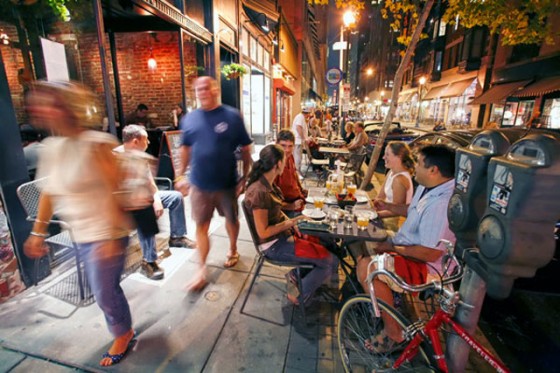More evidence that walkability is financially positive

Many of us know empirically that walkable neighborhoods are positives economically, socially and environmentally. We notice that the homes tend to have higher property values, more local businesses, and fewer cars/traffic. However, real estate developers, investors and municipalities don’t make decisions based on empirical data, so thankfully the Brookings Institution published a report that provides more quantitative evidence (using one major metropolitan area as a case study) that backs up what is common sense to many: “Walk this way: The economic promise of walkable places in metropolitan Washington, D.C.”
Here are the major findings:
More walkable places perform better economically. As the number of features that support walkability and attract pedestrians increase, so do office, residential, and retail rents, retail revenues, and residential values. Investors can take those facts to the bank.
Walkable places benefit from being near other walkable places. Walkable neighborhoods that cluster and form with one another to establish larger walkable districts, exhibit higher rents and home values than stand-alone walkable places. Strength in numbers. This demonstrates the value a city can provide investors, reassuring investors who are investing in walkability on the block level where the city is investing on a district level.
Residents of more walkable places have lower transportation costs and higher transit access, but also higher housing costs. Residents of more walkable neighborhoods generally spend around 12% of their income on transportation and 30% on housing, while residents of places with less walkability spend around 15% on transportation and 18% on housing. This is most assuredly the result of demand exceeding supply, since the construction costs of building a home are pretty much similar within the same city.
Residents of places with poor walkability are generally less affluent and have lower educational attainment, while places with more walkability features have become more gentrified over the past decade. There is no significant difference in terms of transit access to jobs between poor and good walkable places. Again, supply and demand. Thankfully, it’s a lot easier today to make a neighborhood more walkable (adding buildings) than less walkable (removing buildings).
The study also provides prescriptions for what the five sets of stakeholders can do to support a more walkable community, ideally in unison: private developers and investors (use the study’s five levels of neighborhood walkability assessments to assess risk), social equity advocates (advocate workforce housing), the public sector (use the walkability assessments to inform walkable infrastructure allocations) , place managers (business improvement districts and redevelopment agencies set walkability goals), and citizen-led groups/activists (i.e. crowdsource a walkable community).
You can download the report at Urban Imprints, the urban consulting and research firm that produced the report with renowned financial analyst, Chris Leinberger of Brookings, and also a slide presentation highlighting the findings here. For solution oriented folks, the slide presentation introduces State of Place , an urban planning tool that diagnoses a neighborhood’s walkability, allowing you to customize strategic approaches in policy, design, development, investment and planning in making your city more walkable.
Photo of downtown Philadelphia by G. Widman for GPTMC

Leave a Reply